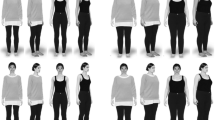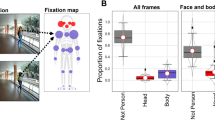Abstract
Although objectification theory suggests that women frequently experience the objectifying gaze with many adverse consequences, there is scant research examining the nature and causes of the objectifying gaze for perceivers. The main purpose of this work was to examine the objectifying gaze toward women via eye tracking technology. A secondary purpose was to examine the impact of body shape on this objectifying gaze. To elicit the gaze, we asked participants (29 women, 36 men from a large Midwestern University in the U.S.), to focus on the appearance (vs. personality) of women and presented women with body shapes that fit cultural ideals of feminine attractiveness to varying degrees, including high ideal (i.e., hourglass-shaped women with large breasts and small waist-to-hip ratios), average ideal (with average breasts and average waist-to-hip ratios), and low ideal (i.e., with small breasts and large waist-to-hip ratios). Consistent with our main hypothesis, we found that participants focused on women’s chests and waists more and faces less when they were appearance-focused (vs. personality-focused). Moreover, we found that this effect was particularly pronounced for women with high (vs. average and low) ideal body shapes in line with hypotheses. Finally, compared to female participants, male participants showed an increased tendency to initially exhibit the objectifying gaze and they regarded women with high (vs. average and low) ideal body shapes more positively, regardless of whether they were appearance-focused or personality-focused. Implications for objectification and person perception theories are discussed.
Similar content being viewed by others
References
Archer, D., Iritani, B., Kimes, D. D., & Barrios, M. (1983). Face-ism: Five studies of sex differences in facial prominence. Journal of Personality and Social Psychology, 45, 725–735. doi:10.1037/0022-3514.45.4.725.
Bartky, S. L. (1990). Femininity and domination: Studies in the phenomenology of oppression. New York: Routledge.
Baumeister, R. F., Vohs, K. D., & Funder, D. C. (2007). Psychology as the science of self-reports and finger movements: What happened to actual behavior? Psychological Science, 2, 396–403. doi:10.1111/j.1745-6916.2007.00051.x.
Bernard, P., Gervais, S. J., Allen, J., Campomizzi, S., & Klein, O. (2012). Integrating sexual objectification with object versus person recognition: The sexualized body-inversion hypothesis. Psychological Science, 23, 469–471. doi:10.1177/0956797611434748.
Bodenhausen, G. V., & Macrae, C. (1998). Stereotype activation and inhibition. In R. R. Wyer & R. R. Wyer (Eds.), Stereotype activation and inhibition (pp. 1–52). Mahwah, NJ US: Lawrence Erlbaum Associates Publishers.
Brewer, M. B. (1988). A dual process model of impression formation. In T. K. Srull & R. R. Wyer (Eds.), A dual process model of impression formation (pp. 1–36). Hillsdale, NJ England: Lawrence Erlbaum Associates, Inc.
Calogero, R. M. (2004). A test of objectification theory: The effect of the male gaze on appearance concerns in college women. Psychology of Women Quarterly, 28, 16–21. doi:10.1111/j.1471-6402.2004.00118.
Cikara, M., Eberhardt, J. L., & Fiske, S. T. (2011). From agents to objects: Sexist attitudes and neural responses to sexualized targets. Journal of Cognitive Neuroscience, 23, 540–551. doi:10.1162/jocn.2010.21497.
Cowan, N. (2005). Working memory capacity. New York: Psychology Press.
Davidson, M. M., Gervais, S. J., Canivez, G. L., & Cole, B. P. (2013). A psychometric examination of the interpersonal sexual objectification scale among college men. Journal of Counseling Psychology, 60, 239–250. doi:10.1037/a0032075.
Dion, K., Berscheid, E., & Walster, E. (1972). What is beautiful is good. Journal of Personality and Social Psychology, 24, 285–290. doi:10.1037/h0033731.
Dixson, B. J., Grimshaw, G. M., Linklater, W. L., & Dixson, A. F. (2010). Watching the hourglass: Eye tracking reveals men’s appreciation of the female form. Human Nature, 21, 355–370. doi:10.1007/s12110-010-9100-6.
Dixson, B. J., Grimshaw, G. M., Linklater, W. L., & Dixson, A. F. (2011). Eye tracking of men’s preferences for waist-to-hip ratio and breast size of women. Archives of Sexual Behavior, 40, 43–50. doi:10.1007/s10508-009-9523-5.
Eagly, A. H., Ashmore, R. D., Makhijani, M. G., & Longo, L. C. (1991). What is beautiful is good, but…: A meta-analytic review of research on the physical attractiveness stereotype. Psychological Bulletin, 110, 109–128. doi:10.1037/0033-2909.110.1.109.
Ekman, P. (1993). Facial expression and emotion. American Psychologist, 48, 384–392. doi:10.1037/0003-066X.48.4.384.
Engeln-Maddox, R., Miller, S. A., & Doyle, D. M. (2011). Tests of objectification theory in gay and lesbian samples: Mixed evidence for proposed pathways. Sex Roles, 65, 518–532. doi:10.1007/s11199-011-9958-8.
Fiske, S. T., & Neuberg, S. L. (1990). A continuum of impression formation, from category-based to individuating processes: Influences of information and motivation on attention and interpretation. In M. P. Zanna (Ed.), Advances in experimental social psychology (Vol. 23, pp. 1–74). New York: Academic.
Fredrickson, B. L., & Roberts, T. (1997). Objectification theory: Toward understanding women’s lived experiences and mental health risks. Psychology of Women Quarterly, 21, 173–206. doi:10.1111/j.1471-6402.1997.tb00108.
Gervais, S. J., Bernard, P., Klein, O., & Allen, J. (2013a). Toward a unified theory of objectification and dehumanization. In S. J. Gervais (Ed.), Objectification and (De)Humanization (pp. 1–24). New York, NY: Springer.
Gervais, S. J., DiLillo, D., & McChargue, D. (2013b). Understanding the link between men’s alcohol use and sexual violence: The mediating role of sexual objectification. Psychology of Violence. doi: 10.1037/a0033840.
Gervais, S. J., Vescio, T. K., & Allen, J. (2011). When what you see is what you get: The consequences of the objectifying gaze for men and women. Psychology of Women Quarterly, 35, 5–17. doi:10.1177/0361684310386121.
Gervais, S. J., Vescio, T. K., & Allen, J. (2012a). A test of the fungibility hypothesis from sexual objectification theory. British Journal of Social Psychology, 51, 499–513. doi:10.1111/j.2044-8309.2010.02016.x.
Gervais, S. J., Vescio, T. K., Förster, J., Maass, A., & Suitner, C. (2012b). Seeing women as objects: The sexual body part recognition bias. European Journal of Social Psychology, 42, 743–753. doi:10.1002/ejsp.1890.
Gueguen, N. (2007). Women’s bust size and men’s courtship solicitation. Body Image, 4, 386–390. doi:10.1016/j.bodyim.2007.06.006.
Hall, J. A., Coats, E. J., & Smith LeBeau, L. (2005). Nonverbal behavior and the vertical dimension of social relations: A meta-analysis. Psychological Bulletin, 131, 898–924. doi:10.1037/0033-2909.131.6.898.
Heflick, N. A., & Goldenberg, J. L. (2009). Objectifying Sarah Palin: Evidence that objectification causes women to be perceived as less competent and less fully human. Journal of Experimental Social Psychology, 45, 598–601. doi:10.1016/j.jesp.2009.02.008.
Heflick, N. A., Goldenberg, J. L., Cooper, D. P., & Puvia, E. (2011). From women to objects: Appearance focus, target gender, and perceptions of warmth, morality and competence. Journal of Experimental Social Psychology, 47, 572–581. doi:10.1016/j.jesp.2010.12.020.
Heflick, N. A., & Goldenberg, J. L. (2011). Sarah Palin, a nation object(ifie)s: The role of appearance focus in the 2008 U.S. presidential election. Sex Roles, 65, 149–155. doi:10.1007/s11199-010-9901-41.
Heilman, M. E., & Stopeck, M. H. (1985). Being attractive, advantage or disadvantage? Performance-based evaluations and recommended personnel actions as a function of appearance, sex, and job type. Organizational Behavior and Human Decision Processes, 35, 202–215. doi:10.1016/0749-5978(85)90035-4.
Henderson, J. M. (2003). Human gaze control during real-world scene perception. Trends in Cognitive Sciences, 7, 498–504. doi:10.1016/j.tics.2003.09.006.
Henderson, J. M., Williams, C. C., Castelhano, M. S., & Falk, R. J. (2003). Eye movements and picture processing during recognition. Perception & Psychophysics, 65, 725–734. doi:10.3758/BF03194809.
Henley, N. (1977). Body politics: Power, sex, and nonverbal communication. Englewood Cliffs: Prentice-Hall.
Hewig, J., Trippe, R. H., Hecht, H., Straube, T., & Miltner, W. R. (2008). Gender differences for specific body regions when looking at men and women. Journal of Nonverbal Behavior, 32, 67–78. doi:10.1007/s10919-007-0043-5.
Holland, E., & Haslam, N. (2013). Worth the weight: The objectification of overweight versus thin targets. Psychology of Women Quarterly. Advance online publication. doi:10.1177/0361684312474800.
Johnson, V., & Gurung, R. R. (2011). Defusing the objectification of women by other women: The role of competence. Sex Roles, 65, 177–188. doi:10.1007/s11199-011-0006-5.
Johnson, K. L., Lurye, L. E., & Tassinary, L. G. (2010). Sex categorization among preschool children: Increasing utilization of sexually dimorphic cues. Child Development, 81, 1346–1355. doi:10.1111/j.1467-8624.2010.01476.
Johnson, K. L., & Tassinary, L. G. (2005). Perceiving sex directly and indirectly: Meaning in motion and morphology. Psychological Science, 16, 890–897. doi:10.1111/j.1467-9280.2005.01633.
Kaschak, E. (1992). Engendered lives: A new psychology of women’s experience. New York: Basic Books.
Kilbourne, J., & Pipher, M. (1999). Deadly persuasion: Why women and girls must fight the addictive power of advertising. New York: Free Press.
Kozee, H. B., Tylka, T. L., Augustus-Horvath, C. L., & Denchik, A. (2007). Development and psychometric evaluation of the interpersonal sexual objectification scale. Psychology of Women Quarterly, 31, 176–189. doi:10.1111/j.1471-6402.2007.00351.
Lindner, D., Tantleff-Dunn, S., & Jentsch, F. (2012). Social comparison and the ‘circle of objectification’. Sex Roles, 67, 222–235. doi:10.1007/s11199-012-0175-x.
Lippa, R. (1983). Sex typing and the perception of body outlines. Journal of Personality, 51, 667–682. doi:10.1111/j.1467-6494.1983.tb00873.
Loughnan, S., Haslam, N., Murnane, T., Vaes, J., Reynolds, C., & Suitner, C. (2010). Objectification leads to depersonalization: The denial of mind and moral concern to objectified others. European Journal of Social Psychology, 40, 709–717. doi:10.1002/ejsp.755.
Loughnan, S., Fernandez, S., Vaes, J., Anjum, G., Aziz, M., Harada, C., … Tsuchiya, K. (2013). Sexual objectification is common in Western, but not non-Western nations: A seven nation study of sexual objectification. Manuscript submitted for publication.
Miller, G. A. (1956). The magic number seven, plus or minus two: Some limits on our capacity for processing information. Psychological Review, 63, 81–97. doi:10.1037/h0043158.
Moradi, B., & Huang, Y. (2008). Objectification theory and psychology of women: A decade of advances and future directions. Psychology of Women Quarterly, 32, 377–398. doi:10.1111/j.1471-6402.2008.00452.
Morton, J., & Johnson, M. H. (1991). CONSPEC and CONLERN: A two-process theory of infant face recognition. Psychological Review, 98, 164–181. doi:10.1037/0033-295X.98.2.164.
Mulvey, L. (1975). Visual pleasure and narrative cinema. Screen, 16, 6–18.
Pope, H., Katz, D., & Hudson, J. (1993). Anorexia nervosa and “reverse anorexia” among 108 male bodybuilders. Comprehensive Psychiatry, 34, 406–409. doi:10.1016/0010-440X(93)90066-D.
Puvia, E., & Vaes, J. (2012). Being a body: Women’s appearance related self-views and their dehumanization of sexually objectified female targets. Sex Roles, 68, 484–495. doi:10.1007/s11199-012-0255-y.
Saguy, T., Quinn, D. M., Dovidio, J. F., & Pratto, F. (2010). Interacting like a body: Objectification can lead women to narrow their presence in social interactions. Psychological Science, 21, 178–182. doi:10.1177/0956797609357751.
Stangor, C., Lynch, L., Duan, C., & Glass, B. (1992). Categorization of individuals on the basis of multiple social features. Journal of Personality and Social Psychology, 62, 207–218. doi:10.1037/0022-3514.62.2.207.
Strelan, P., & Hargreaves, D. (2005). Women who objectify other women: The vicious circle of objectification? Sex Roles, 52, 707–712. doi:10.1007/s11199-005-3737-3.
Vaes, J., & Latrofa, M. (under review). From ogling to dehumanization: The objectifying gaze.
Vaes, J., Paladino, P., & Puvia, E. (2011). Are sexualized women complete human beings? Why men and women dehumanize sexually objectified women. European Journal of Social Psychology, 41, 774–785. doi:10.1002/ejsp.824.
Young, I. M. (2003). Breasted experience: The look and the feeling. In R. Weitz (Ed.), The politics of women’s bodies (pp. 152–163). New York, NY: Oxford University Press.
Yu, D. W., & Shepard, G. H. (1998). Is beauty in the eye of the beholder? Nature, 396, 321–322. doi:10.1038/24512.
Zelazniewicz, A. M., & Pawlowski, B. (2011). Female breast size attractiveness for men as a function of sociosexual orientation (restricted vs. unrestricted). Archives of Sexual Behavior, 40, 1129–1135.
Zurbriggen, E. L., Ramsey, L. R., & Jaworski, B. K. (2011). Self- and partner-objectification in romantic relationships: Associations with media consumption and relationship satisfaction. Sex Roles, 64, 449–462. doi:10.1007/s11199-011-9933-4.
Acknowledgments
This research was supported in part by a Layman Award to Sarah J. Gervais from the Office of Research at the University of Nebraska-Lincoln. This research was also supported in part by the McNair Scholars Program Summer Research Internship (U.S. Department of Education), the Research Experience for Undergraduates Award (National Science Foundation), and the Undergraduate Creative Activities and Research Experiences Program (Pepsi Endowment) from the University of Nebraska-Lincoln to Arianne M. Holland. We would like to thank Angie Dunn for assistance with data collection, Devon Kathol and Justin Escamilla for assistance with stimulus creation, and Mark Mills for assistance with data analysis.
Author information
Authors and Affiliations
Corresponding author
Appendix
Appendix

Rights and permissions
About this article
Cite this article
Gervais, S.J., Holland, A.M. & Dodd, M.D. My Eyes Are Up Here: The Nature of the Objectifying Gaze Toward Women. Sex Roles 69, 557–570 (2013). https://doi.org/10.1007/s11199-013-0316-x
Published:
Issue Date:
DOI: https://doi.org/10.1007/s11199-013-0316-x




